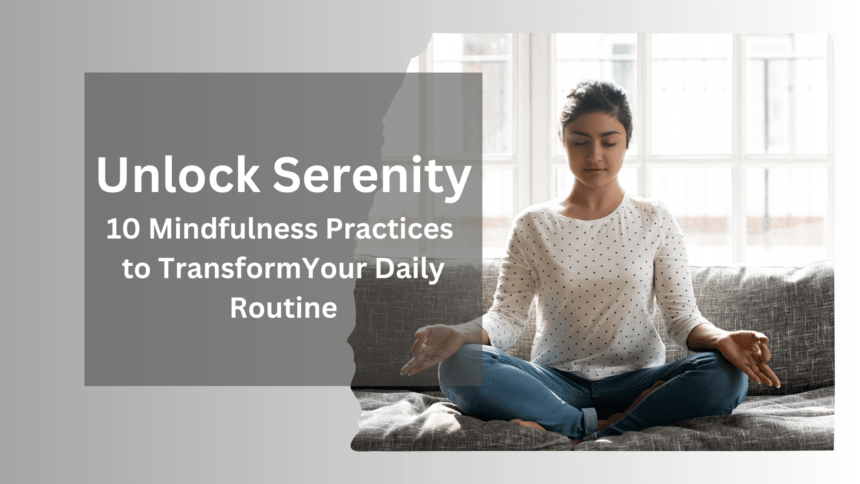Introduction to Mindfulness
Definition and Importance
Mindfulness, a term that has become ubiquitous in contemporary wellness discourse, is fundamentally the practice of maintaining a moment-by-moment awareness of our thoughts, feelings, bodily sensations, and surrounding environment. Rooted in ancient contemplative traditions, mindfulness is more than just a trendy buzzword; it is a profound approach to life that cultivates presence, reduces stress, and enhances overall well-being.
Historical Context and Evolution
Originating from Buddhist meditation practices, mindfulness practices has evolved through centuries, transcending religious boundaries to become a universally applicable tool for mental and emotional regulation. Today, its principles are integrated into various therapeutic modalities, from Mindfulness-Based Stress Reduction (MBSR) to Mindfulness-Based Cognitive Therapy (MBCT), reflecting its broad acceptance and efficacy.
1. Morning Meditation
Benefits of Starting Your Day with Meditation
Commencing your day with a meditation session sets a serene and focused tone for the hours to come. It acts as a mental detox, clearing the clutter of the previous day’s anxieties and preparing the mind to embrace the new day with clarity and purpose. Research indicates that morning meditation can enhance mood, improve concentration, and increase resilience against daily stressors.
Simple Techniques to Begin
Starting with just five minutes of quiet meditation can be profoundly beneficial. Find a comfortable seat, close your eyes, and focus on your breath. Allow thoughts to pass without judgment, gently bringing your focus back to your breath whenever your mind wanders. Over time, you can extend the duration and explore various meditation styles such as guided, mantra, or loving-kindness meditation.
2. Mindful Breathing
The Science Behind Conscious Breathing
Breathing is an automatic process, but mindful breathing transforms it into a powerful tool for calming the nervous system. When we focus on our breath, we engage the parasympathetic nervous system, which counteracts the fight-or-flight response, reducing stress and promoting relaxation. This practice also enhances oxygen flow, improving overall physical health.
Techniques to Practice Anywhere
Mindful breathing can be practiced anywhere, at any time. One effective technique is the 4-7-8 breath: inhale for four seconds, hold the breath for seven seconds, and exhale slowly for eight seconds. This method not only calms the mind but also regulates the heartbeat, promoting a sense of tranquility. Another simple practice is to just take three deep, slow breaths whenever you feel stressed or overwhelmed.
3. Gratitude Journaling
Psychological Benefits of Gratitude
Gratitude journaling involves regularly writing down things you are grateful for, fostering a positive mindset. Studies have shown that expressing gratitude can enhance emotional well-being, reduce symptoms of depression, and improve overall life satisfaction. This practice shifts focus from negative to positive experiences, cultivating an attitude of appreciation and contentment.
How to Start a Gratitude Journal
Begin by setting aside a few minutes each day to write in your gratitude journal. Note down three to five things you are thankful for, no matter how small. Reflect on these entries to deepen your sense of appreciation. Over time, this practice can rewire your brain to recognize and focus on the positive aspects of your life, fostering a more optimistic outlook.
4. Mindful Eating
Understanding the Concept of Mindful Eating
Mindful eating involves paying full attention to the experience of eating and drinking, both in and out of the body. It’s about savoring each bite, noticing the colors, smells, textures, flavors, temperatures, and even the sounds of the food. This practice not only enhances the pleasure of eating but also helps in recognizing hunger and fullness cues, promoting healthier eating habits.
Practical Tips for Eating Mindfully
To practice mindful eating, start by eating more slowly and chewing thoroughly. Put down your utensils between bites and focus on the sensory experience of eating. Avoid distractions such as television or smartphones during meals. By being fully present during your meals, you can develop a healthier relationship with food and improve your digestion.
5. Body Scan Meditation
What is Body Scan Meditation?
Body scan meditation is a mindfulness practice that involves paying attention to different parts of your body, from your toes to your head. It helps in developing greater awareness of bodily sensations, which can lead to improved emotional regulation and stress reduction. This practice can also help in identifying areas of tension or discomfort, promoting relaxation and self-care.
Step-by-Step Guide to Practice
To begin a body scan meditation, find a comfortable and quiet place to lie down. Close your eyes and take a few deep breaths. Start by focusing on your toes, noticing any sensations. Gradually move your attention up through your legs, torso, arms, and head, pausing at each body part. If you encounter tension or discomfort, acknowledge it without judgment and move on. This practice can be done for as little as five minutes or as long as an hour.
6. Digital Detox
Impact of Technology on Mental Health
The omnipresence of digital devices has a profound impact on mental health, often leading to increased stress, anxiety, and sleep disturbances. Constant notifications and the pressure to stay connected can overwhelm the mind, reducing the ability to focus and be present. A digital detox can mitigate these effects, restoring balance and mental clarity.
Strategies for a Successful Digital Detox
Start by setting specific times during the day to check your devices and stick to them. Create tech-free zones in your home, such as the dining area and bedroom. Engage in activities that don’t involve screens, like reading a book, taking a walk, or engaging in a hobby. These small changes can significantly reduce digital overload and enhance your mindfulness practice.
7. Walking Meditation
Combining Physical Activity with Mindfulness
Walking meditation involves focusing on the physical experience of walking, using the movement as the object of your attention. This practice integrates physical exercise with mindfulness, promoting both physical and mental well-being. It can be done anywhere and is especially beneficial for those who find sitting meditation challenging.
Tips for Effective Walking Meditation
To practice walking meditation, find a quiet space where you can walk slowly and uninterrupted. Pay attention to the sensation of your feet touching the ground, the movement of your legs, and your overall posture. Walk at a natural pace, focusing on each step. If your mind wanders, gently bring your attention back to the sensation of walking. This practice can be particularly grounding and calming.
8. Mindful Listening
Enhancing Relationships through Mindful Listening
Mindful listening involves fully focusing on the speaker, without interrupting or planning your response. This practice enhances communication, builds empathy, and strengthens relationships. By being fully present during conversations, you can better understand and connect with others, fostering deeper and more meaningful interactions.
Techniques to Improve Listening Skills
To improve mindful listening, start by giving the speaker your undivided attention. Maintain eye contact and nod or give verbal affirmations to show you are engaged. Avoid interrupting or jumping to conclusions. Reflect back what you’ve heard to ensure understanding and show that you value the speaker’s perspective. These techniques can transform your communication and relationships.
9. Mindful Bathing
Transforming Bathing into a Mindful Practice
Bathing can be transformed into a mindfulness practices by focusing on the sensory experience of the water and the act of cleansing. This practice not only promotes relaxation but also enhances the connection with your body. By being fully present during bathing, you can turn this routine activity into a restorative ritual.
Steps to a Mindful Bath
To practice mindful bathing, start by setting an intention to be present during your bath or shower. Pay attention to the sensation of the water on your skin, the temperature, and the smell of any soaps or shampoos. Take deep breaths and enjoy the moment. This practice can be particularly calming before bedtime, helping to unwind and soothe both the body and mind.
10. Visualization Techniques
Power of Visualization in Mindfulness Practices
Visualization is a powerful tool in mindfulness practices that involves creating vivid mental images to achieve a specific state of mind or goal. This technique leverages the mind’s ability to influence physical and emotional well-being. By visualizing positive outcomes, serene environments, or successful achievements, you can harness the power of your imagination to reduce stress, enhance focus, and foster a sense of inner peace.
Practical Visualization Exercises
To practice visualization, find a quiet and comfortable place to sit or lie down. Close your eyes and take a few deep breaths to center yourself. Begin by imagining a peaceful scene, such as a tranquil beach, a lush forest, or a serene mountain landscape. Engage all your senses: feel the warmth of the sun, hear the gentle rustling of leaves, smell the fresh air. Alternatively, you can visualize achieving a personal goal, picturing each step and the positive emotions associated with success. Practicing visualization for just a few minutes each day can significantly enhance your mindfulness practices and overall well-being.
Conclusion
Integrating mindfulness practices into your daily routine is a transformative journey that cultivates a deeper sense of presence, tranquility, and resilience. By incorporating these ten mindfulness practices—morning meditation, mindful breathing, gratitude journaling, mindful eating, body scan meditation, digital detox, walking meditation, mindful listening, evening reflection, and mindful bathing—into your daily life, you can create a harmonious balance between mind, body, and spirit. These mindfulness practices not only alleviate stress and enhance emotional well-being but also enrich the quality of your relationships and the depth of your daily experiences.
Mindfulness practices is not a one-size-fits-all approach; it is a personalized journey that evolves with you. As you explore and integrate these practices, you may find some resonate more deeply than others. The key is consistency and patience, allowing yourself the grace to grow and adapt. Embrace mindfulness as a lifelong journey, and let it guide you towards a more centered, peaceful, and fulfilling life.
For more content follow Humstory.













